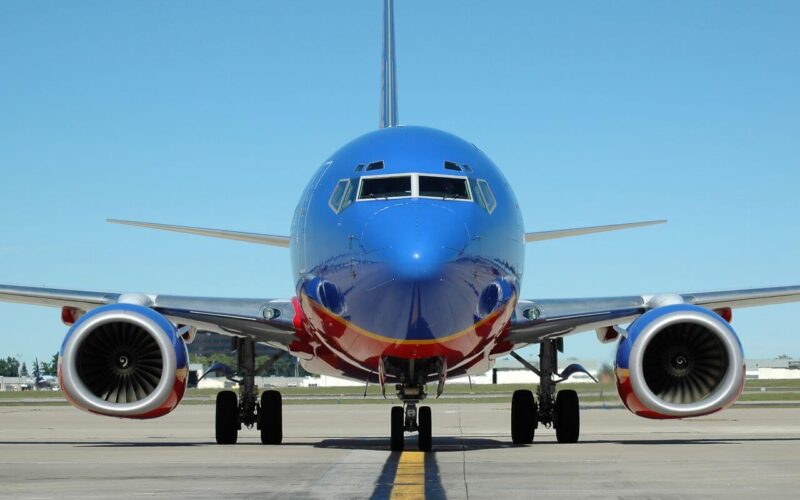Following a lengthy investigation into the deadly Southwest Airlines (LUV) flight 1380 in April 2018, the U.S. National Transportation Safety Board (NTSB) urged Boeing on November 19, 2019, to redesign the fan cowl on all 737 Next Generation family aircraft and operators of the type to retrofit their airplanes with the new design. This comes after investigators found the fan cowl structure on the 737NGs to be more “susceptible” to failure.
The NTSB has determined that the engine failure on the Southwest Boeing 737-700 (N772SW) was caused by a broken fan blade from one of the two CFM International CFM-56-7Bs powering the aircraft.
As part of its probable cause, the board noted that the accident occurred when portions of the (left) fan cowl separated in-flight. A fan blade (No. 13), which had fractured due to a low-cycle fatigue crack, impacted the engine fan case at a location that was critical to the structural integrity of the fan cowl.
The separated fan blade impacted the engine fan case and fractured into multiple fragments, some of which traveled forward of the engine and into the inlet. The impact to the fan case also imparted significant loads into the fan cowl through the radial restraint fitting, which is what caused the fan cowl to fail, investigators described.
The fractured fan blade led the engine inlet and fan cowl to break apart, subsequently damaging the airplane’s fuselage and resulting in rapid cabin depressurization. Fragments of the fan cowl struck the fuselage near a cabin window – one passenger died after being partially sucked out of the blown-out window. Eight others suffered minor injuries.
The accident happened during climb after Southwest flight 1380 departed New York’s LaGuardia Airport (LGA), bound for Dallas Love Field (DAL), Texas on April 17, 2018. The flight crew were forced to divert and make an emergency landing at Philadelphia International Airport (PHL). There were 144 passengers and five crew members on board.
NTSB reveals findings
As a result of the investigation, the NTSB issued seven new safety recommendations: five were sent to the U.S. Federal Aviation Administration (FAA), one to the European Union Aviation Safety Agency (EASA), and one to Southwest Airlines (LUV) . The recommendations primarily address “the need to ensure the structural integrity” of the fan cowl on Boeing 737 NG airplanes and assess whether other airframe and engine combinations have critical fan blade impact locations.
“This accident demonstrated the susceptibility of the fan cowl installed on Boeing 737 next-generation-series airplanes to a fan-blade-out impact location near the radial restraint fitting and the effects of such an impact on the structural integrity of the fan cowl,” the NTSB revealed in its findings.
“Given the results of CFM’s engine fan-blade-out (FBO) containment certification tests and Boeing’s post-accident structural analyses of the effects of an FBO event on the airframe, the post-FBO events that occurred during this accident could not have been predicted.”
Essentially, Boeing’s post-accident analyses found that the fan cowl structure is more susceptible to failure than previously expected.
“This accident demonstrates that a fan blade can fail and release differently than that observed during engine certification testing and accounted for in airframe structural analyses,” said NTSB Chairman Robert Sumwalt in the accident report.
“It is important to go beyond routine examination of fan blades; the structural integrity of the engine nacelle components for various airframe and engine combinations needs to be ensured,” he added.
NTSB wants 737NG part redesigned
In its recommendations to the FAA, the safety board stated that the regulator should require Boeing to determine the fan blade impact location(s) on the CFM56-7B engine fan case and redesign the structure on all 737 NG series airplanes.
In addition, Boeing should install the redesigned fan cowl structure on newly manufactured 737 NGs. No groundings of the airplane have been necessitated as of yet, however, current operators of the type are expected to retrofit their airplanes with the redesigned part to minimize the potential of an engine failure.
Boeing 737NGs and Southwest: a bad combination?
In fact, the Southwest accident in April 2018 was the second such occurrence. As the NTSB accident report shows, the board had also been investigating an August 2016 engine failure on another Southwest 737-700 equipped with CFM56-7B engines. The incident, which did not result in any injuries to passengers, was also an FBO event. The final report for the investigation of the Southwest flight 1380 accident is expected to be published “in the next few weeks,” the NTSB states.
In a statement on NTSB recommendations, Boeing ensured that all 737 NGs are “safe to continue operating normally” as the issue is “completely mitigated by the fan blade inspections.” The manufacturer also said it is working on a design enhancement “that would fully address the safety recommendation from the NTSB. Once approved by the FAA, that design change will be implemented in the existing NG fleet over the longer term.”
Since the Southwest flight 1380, the FAA has issued numerous, subsequent directives requiring fan blade inspections on the CFM56-7B engine fleet and said it would “carefully review and respond to the NTSB recommendations,” Reuters reported November 19, 2019.
Earlier in November, the FAA threatened Southwest to ground 38 of its Boeing 737s due to concerns related to their operational history, namely performed maintenance while they were flown by other airlines from outside the U.S. The airline found several aircraft with substandard or improper repairs done on the jets by their previous owners overseas.
The paperwork about the aforementioned repairs were also found to be unreliable, meaning that neither the FAA nor Southwest can confirm the second-hand 737s meet all safety requirements. It is not the first time that the airline is under fire due to the paperwork shortcomings of its second-hand aircraft either.

